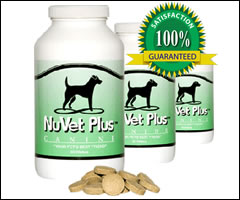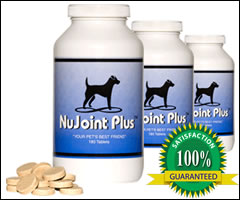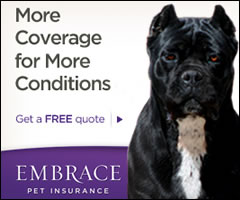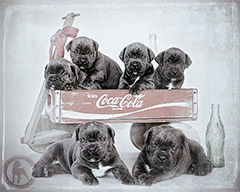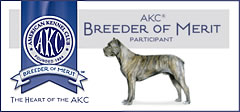| * Home * About Us * Available Puppies & Dogs * Sales Policies * | |


New Puppy Care
|
New Puppy Care - Bringing Home an About Time Cane Corso!This page is written to help answer many of the questions that frequently come up about bringing a new puppy into your lives. It covers many things from feeding to training, socialization to housebreaking, vaccinations, supplements, and more! If you are bringing a new "About Time" puppy into your home, please take the time to read this whole page before your puppy arrives - there is a wealth of information here, you will be glad you did! If you are looking for additional information on a certain topic, please be sure to browse our Cane Corso Care and Health sections.
Feeding Your Cane Corso:Our dogs are fed a combination of a natural raw diet, fresh raw beef, bones, and organ meats, home cooked meals, and high quality corn-free dry kibble. We feed our dogs and pups a variety of high quality corn free kibbles including Nature's Domain (from Costco), Innova's Large Breed Puppy, Evo, and Diamond Super Premium Chicken & Rice. Innova & Evo, and Nature's Domain info and dealer locations provided on our link resources page). We vary raw diet and kibble type based on protein content and the age, condition, and nutritional needs of each individual dog. We also include some supplements based on our preference for ideal dietary needs of each dog.
Changing your dog's food type:Start your Cane Corso on their accustomed food for the first couple days while they are settling in. When you are ready to change the kibble, on the first day add just a small amount of the new kibble, then the second day mix 1/4 of the new food with 3/4 of the original food. The third day you will mix 1/2 new food with 1/2 original food, and the fourth day mix 3/4 new food with 1/4 old food. In this manner you can change the dog completely over to your preferred food type in just 5 days, without bothering their stomachs.
Protein Content & Quality:Regardless of the brand of kibble you prefer, Protein and Calcium content play a key factor in the growth of your Cane Corso puppy. As a large breed puppy your Cane Corso has the potential to grow too fast and put additional stress and strain on still maturing joints and hips if fed a diet that is too high in protein and calcium. Growing pups, up to two years of age, will do best on a lower protein diet designed for large breed puppies. The protein level you feed can be reached thru a combination of kibble, raw feeding, and supplements (Supplements are detailed below on this page). Quality is extremely important in your dog food decision - a cheap food that has lots of "fillers" (corn, etc) will not be digestible or nutritional, and can actually be detrimental to your puppy's health. Many commercial foods are full of cheap fillers, by-products, and artificial preservatives. Taking corn alone out of your dogs diet will keep your dog much happier and healthier in the long run, and likely increase his life span as well. Corn is completely indigestible to dogs, has no nutritional value whatsoever, many dogs are allergic to it, and a corn based diet has been linked to the cause of many cancers, seizures, and canine health issues. As if that is not enough, the corn in our country is genetically modified and loaded with growth hormones to mass produce it for the demand and variety of corn based products - the quality has been sacrificed for the quantity. If your dog, cat, or even yourself, have a predisposition to cancer, those growth hormones will feed that gene, increasing the risk of the growth of cancer. Frightening when you think about it!
Dog Food Quality Rating SystemIf you are curious about the quality of the kibble you are feeding, or simply struggling to decipher which of the many brands available would be the best quality for your dog, use this Dog Food Rating System. This is a simple way to judge the quality of kibble brands - and compare how different dog foods measure up.
Pet Food Recalls & Choosing What You FeedYour choice of kibble for your Cane Corso is very important, especially in light of yet another pet food recall, and the scale of brands, families, and pets affected. Many families were shocked by the unexpected loss of their beloved pets ... many families who thought they were feeding good quality food. Co-Packing: Most people are surprised, and appalled, to learn that all the Iams/Eukanuba canned foods are not made by the Iams Company at all. In fact, in 2003 Iams signed an exclusive 10-year contract for the production of 100% of its canned foods by Menu. This type of deal is called co-packing. One company makes the food, but puts another company’s label on it. Co-packing is a very common arrangement in the pet food industry. While not commonly known, it is often brought to light when a recall is issued, and surprisingly when dozens of "premium" private labels are involved. This practice of co-packing is used by many large and “reputable” labels such as Iams, Eukanuba, Hills, Purina, Nutro, Doanes, Diamond, and other high-end, so-called “premium” foods. Here are Dog Food Recall Lists, from the Food and Drug Administration, and the American Veterinary Medical Association:
Cooking for your dogsOne or two times per week we feed all our dogs a "home-cooked" meal. I will boil a whole chicken until tender, pull all the meat from the bones, and then drop some scrambled raw eggs into the boiling broth (with the chicken pieces) before finishing up with a kettle-full of rice. The end result is rice boiled in chicken broth, with wispy pieces of egg throughout, and shreds of chicken mixed in. A little oil can be added as it is cooking as well. Your dogs will love it! This is an awesome recipe for settling an upset stomach. You can also change up the ingredients for variety, including pasta, sliced potatoes, and some assorted fresh vegetables. We supplement all our dogs diets with Satin Balls (recipe below) a healthy and tempting recipe you can mix together and freeze for easy daily use.
Feeding RawIf you start researching raw diets, you'll hear a vast difference of opinions. Personally, we have found that a natural raw diet has been nothing but beneficial to our dogs. Raw bones and food are what dogs are naturally suited to eat. Commercially prepared cooked foods & kibble lack enzymes and other essential dietary components and contain some ingredients that promote allergies and are otherwise harmful for dogs. The conventional canned and kibble dog foods are convenient and practical to handle, that's why they are so popular. After a couple of years of feeding though, they can be harmful for your dog's liver - especially the super premium types. If you decide to feed raw to your Cane Corso, your options range from packaged medallions of raw food, to simply picking up a couple ribs at the grocery store (and explaining to the family why the dog gets ribs while dinner is spaghetti!). We stop by a small privately owned meat processing company near us once a week and pick up fresh raw beef for all our dogs, and store it in a 14 cubic foot freezer to so their feedings stay fresh all week long. Our dogs ear fresh raw beef, lamb, and goat, raw bones, chicken necks, organ meats (hearts/livers/kidneys etc), and green tripe.
Feeding Both Raw and Processed Kibble TogetherFeeding a natural raw diet has produced outstanding results in our dogs. However, depending on the individual dog and situation, there are many times when we supplement the dog's raw diet with some kibble as well. There is nothing wrong with combining raw and kibble in the same diet, as long as you feed them in the proper order. Raw is what your dog's stomach was designed to digest, as a result raw food is processed and digested quickly and efficiently through your dog's digestive tract. Commercially prepared cooked foods & kibble take longer for your dog to digest and process. If you chose to feed raw and kibble, do not feed both raw and kibble in the same meal together, and do not feed kibble immediately followed by raw. This is a common mistake, following a bowl of kibble with some raw 'dessert', but when fed in this order the raw food gets backed up in the digestive tract behind the slower processing kibble, and remains in the stomach for a much longer period of time that it otherwise would. This extended time can result in a buildup of bacteria that is not healthy for your dog. Better to either feed raw followed by kibble, in separate meals - raw one meal, kibble in a separate meal altogether.
SupplementsWe strongly recommend NuVet Plus immune system builder and NuJoint Plus to all of our clients. We have given your pup the best start possible in life, and we highly recommend you continue your pup's health and hip supplement support, from the time they arrive home to you, on both NuVet Plus to support your pup's immune system for optimal health, and NuJoint Plus to help reduce the risk of Hip Dysplasia. NuVet is not available in stores, and is only available to the general public with an order code from an authorized pet professional.
*SAVE an additional 15% and assure you never run out of NuVet by choosing the “AutoShip” option at check out!
NuVet Plus can help prolong the life of your dog and can help eliminate many ailments, including Allergies, Skin and Coat Problems, Scratching, Itching, Biting, Hot Spots, Arthritis and Joint Problems, Low Energy Levels, Diabetes and Liver Problems, Cataracts and Tumors, Digestive Problems, Tearing, Heart Disease, Premature Aging. NuVet Plus is not just a vitamin. It’s an immune system builder with a precise balance of vitamins, minerals, omega fatty acids, amino acids and high-potency antioxidants. That’s why it works so well through all three stages of a dog’s life. For younger dogs (under 2 years old), it strengthens their immune system, while building and strengthening the cardiovascular, skeletal and nerve systems. For dogs in their prime (age 2-8), it improves the luster of their skin and coat while protecting against allergies, skin and coat problems, staining from tears, digestive problems, etc. For older dogs (over 8 years old), it helps protect against, tumors, premature aging, cataracts, heart conditions, diabetes and many types of cancer, while extending the life and improving the vitality of many dogs. Click here to ORDER NuVet Plus for your pup's health and immune system!
NuJoint Plus is a carefully formulated nutritional pet supplement, using only the highest quality pharmaceutical, human grade ingredients that are specifically compounded in a FDA approved laboratory for maximum potency and effectiveness. NuJoint Plus uses a cutting edge formula that targets disease causing pathogens and free radicals by infusing the cellular framework of your pet’s metabolism with precise percentages of Glucosamine, Chondroitin, Methylsulfonylmethane (MSM), and Vitamin C. Click here to ORDER NuJoint Plus for your pup's hips and joints!
Natural Nutritional Extras
The above mayonnaise, oil and egg supplements are high in protein and fat. Used correctly and in moderation they will produce a shiny healthy coat, and they will help prevent dry/flaky skin and hair problems as well. Do keep in mind though, an overweight fat puppy is not a healthy puppy and is going to be more prone to hip/joint problems. When used with moderation to feed the average active pup that this is never really a problem, but pay attention. If your pup starts to get chunky, you need to slow down on the extras.
Satin Balls Satin Balls are a total canine diet. They can be feed by by themselves or as a supplement, used to build up a show dog, or develop a healthy appetite for a picky eater. They will increase weight on thin dogs, build healthy soft skin and glossy coats, alleviate itching and chewing at dry coats/skin, and maintain a bright-eyed look and healthy energy level. Satin Balls Recipe and Instructions
Feeding Raw EggsWe feed raw eggs to all the adult dogs at various times. Eggs are very good for dogs. In fact, they are the most concentrated, valuable form of protein that a dog can get. HOWEVER, with young puppies you never want to feed them uncooked egg whites. Raw egg yolks are just fine for pups, but pups are unable to digest raw/uncooked egg whites. Egg whites contain an enzyme inhibitor which can make them difficult to digest for very young puppies, sick dogs, old dogs, or dogs with pancreatitis. Apart from that, unless a dog has an allergy to eggs, there should be no problem. Egg whites contain a substance called avidin, which binds with the vitamin biotin (a member of the B Complex group), making it unavailable for your dog. This has been shown in studies to not be a problem when a dog is fed a balanced healthy diet - only when a dog was fed no biotin for weeks while being fed large amounts of eggs did it begin to cause a deficiency. Also, egg yolks contain a high amount of biotin so when whole eggs are fed it is not a problem. The yolks are healthier for the dog uncooked, but in the instances listed above, the whites are better cooked than raw. This is the reason for dropping the eggs for just 30 seconds in boiling water. It gives the best benefit from both the whites (partially cooked) and the yolk (still uncooked). The reason you include the entire egg - shells and all - is because the shells are high in calcium, phosphorous and other minerals. You can always throw the whole egg, shell and all, in the blender before mixing with the recipe to avoid shell pieces.
Liver Brownies - The BEST Training Treats & Show Bait!Liver Brownies Recipe
Cut liver (and/or hearts) into small chunks and grind in a food processor or blender. In large bowl, mix liver with corn meal, wheat germ, garlic, fennel/anise, and salt. Spread mixture on greased cookie sheet. Bake at 350 degrees for 20 minutes. Allow to cool 10 minutes; cut into squares (while still warm). Another variation is to add an egg to the above recipe, and then force-knead in flour (after mixing the above recipe) until the dough no longer sticks to the working surface. Press/roll this into a 1 inch thick slab with a little more flour on each side, sprinkle some garlic powder on top, and baked on a non-stick cookie sheet in a 350 degree oven for about an hour until it will spring out of the pan on its own, and gives a clean hollow sound when you tap it. Allow to cool 10 minutes; cut into squares (while still warm). The result will be a crunchy crust with a chewy interior. Keep refrigerated, and freeze what will not be used within a week to prevent it from spoiling.
Beds / Blankets / Toys / Chews & More:There is nothing a Corso puppy loves more than soft beds and fluffy blankets to hang out on near you! Leave a couple pet-beds scattered around the house in various rooms, or toss a fluffy blanket on the corner of the couch (bonus points if it is in a sunny spot!) and your Corso will happily bask in your presence as you work around the house. A variety of chew toys, and fun toys should always be available, especially for young energetic puppies. They provide hours of entertainment, help get through the teething process, and are much cheaper to replace than your couch & shoes. "Fuzzy/Squeaky" toys are always a big hit with pups here, but won't last long in unsupervised competition with your pup's sharp teeth and powerful jaws. Our growing pups will spend a couple happy hours chewing and shaking their new "victim" ... then bring me the gutted remains with a quizzical look when it stops squeaking. Braided fleece balls and tugs seem to be among the more durable corso-proof toys we have found. Hard chew toys/treats will help scrape their teeth, and will reduce plaque buildup. We offer a variety of chew treats, including Nylabones, Raw Bones, Bully Sticks, Braided Pizzle Sticks, Antler Chews, rope bones, and more. A couple notes on the subject of treats:
Collars / Harnesses:Choosing a proper collar for your Cane Corso is an important step in beginning your pup's training. You want to start your pup with a flat buckle collar that is wide enough to be gentle thru the learning process (not a choke chain), but also that is strong enough to be well functional. We recommend a flat leather collar or nylon collar that is an inch wide to begin with. Training Collars:
Vaccinations & Worming:All our puppies are current on their vaccinations & worming before leaving. You will receive a your puppy's immunization records when your puppy arrives home to you. We de-worm pups bi-weekly with Earliworm, and vaccinate (at 6, 9, 12 weeks) with a 5-way puppy vaccine. Pups receive their first vaccine at 6 weeks of age, and boosters at three-week intervals after that. If your pup goes home to you before vaccinations are complete, it is vitally important that you take him/her to your vet to receive the remaining boosters. Your puppy *will not* be protected (against parvo, distemper etc.) until a week after he/she has received the full set of vaccinations and booster shots. FULLY Vaccinate ~ BEFORE taking your pup out: Please follow these links for full details on understanding Canine Parvovirus & Canine Distemper.
Other Dogs, Cats, Pets, & Kids:Yes, your Cane Corso can get along with other dogs, toy breed dogs, cats, other pets, and children. Our Corsos coexist peacefully with our birds, indoor house cats, toy breed Italian Greyhounds, our children, toddler, and and our new baby. It all comes down to a matter of training ("it is not 'OK' to chase the cat"), raising them with the other dogs ("even though it is 'snack-size' you are not allowed to eat the little dog"), and appropriate behavior with children ("play gentle with kids, and tolerate any indignities with the option to 'walk away' if it is too bothersome"). Introductions: A couple notes on the subject of Small Dogs: The Cane Corso & Children:
Socializing your puppy: A well-socialized Cane Corso is a Confident, Outgoing, and Fun Loving dog! He is well trained, accepting of new situations, people, and things - both in and out of your home, and is a pleasure to live with. Well socialized dogs are the result of dedicated puppy parents who invest important socialization time into their pup, for it's future. There is a wealth of detail I could share here, but the short and simple puppy socialization golden rule is this: Anything you want your Cane Corso to be accepting of and confident around as an adult, you need to expose it to as a puppy. This means everything from children, adults, strangers, elderly equipment (crutches/wheelchairs/walkers etc), other dogs, cats, livestock, car rides, vet office visits, traffic, pet stores, assorted public places/people/crowds ... your Cane Corso should see, experience, interact with, and become accustomed to and comfortable with as a growing pup. This type of proper puppy socialization will result in calm confident adult dog that will go anywhere with you and face the world with a confident attitude and a wagging tail.
Housetraining:"About Time" puppies are started with housetraining basics already established, and the groundwork laid, to make housebreaking as simple as possible when your new pup arrives home. At 4 weeks of age when the pups start becoming mobile and eating, they are placed in a 5ft square exercise pen in our kitchen. They have a bed, food and water in the front, and paper down to cover the rest of the area. As dogs have a natural instinct to keep their sleeping and eating areas clean, they prefer to eliminate in a different area. At this young (and not totally mobile yet) age, anywhere the pup chooses to go outside of his bed is on paper. As they grow over the next week they will progress naturally to choosing the back corner of their area to eliminate - as far as possible from their food and bed area. Over the next couple weeks, the size of the exercise pen is increased, and the paper is decreased from covering the floor to just an area in the back corner. There is one single word that sums up the key to simple housetraining: CONSISTENCY. The best training tip I've ever heard when it comes to housebreaking... Your pup will arrive with the basic foundation for paper-training already established. From that point on, you just need to build on it. To start, when your pup first arrives home in a new and unfamiliar place, go back to the basics by limiting your pup to a restricted area when feeding and for 30 minutes after meals: food and bed on one side, paper or pee-pad in the back. The pup should pick up right away to go on the paper. Then, once he knows where it is, start increasing the area, but be sure to feed close to the paper so he won't have to go far after eating. Once he clearly knows where the paper is, he will easily begin returning to it on his own. Paper training is your foundation. Changing from paper to going outside is just a matter of steps. Remember, always make changes gradually, and build your new training on your original foundation. To train to go outside, leave the paper down in the house for a backup option, and begin taking your pup out after meals and/or when you notice him starting to circle and sniff for a place to go. When he eliminates outside, praise him heavily, and take him back in. In this manner you can make him understand that you are pleased when he goes outside, and soon he should start looking to go out when he has to eliminate. By leaving paper down inside as well though, you provide a backup in the event that you do not get there fast enough to let him out. At least he can still go on the paper (good puppy) rather than messing on the floor (bad puppy). Positive reinforcement and consistency are your best tools in training your dog. If you forget to watch him, and find a mess on the floor, DO NOT punish your pup after the fact for your inattention. He will not know what you are angry for. Instead, clean it up, and watch more closely the next time. If you catch him "in the act", make a sharp noise of displeasure, and simply pick him up, carry him to the paper or out the door, and then praise him when he finishes there. Praise and treats every time he does right will go much further than yelling when he doesn't. Soon enough you'll end up with a Corso that will come running to find you and show you he made a mess where he was suppost to, just because he wants his reward and treat!
Crate Training / Exercise Pens:Crate-Training Your Puppy: Exercise Pens - Limiting Areas:
Health Care & Pet Insurance:We Recommend Embrace Pet Insurance We Recommend Pet Assure Veterinary Discount Program With the rising cost of vet care, a good pet insurance plan is a simple and low cost way to give yourself the peace of mind knowing you will never have to make the call between getting your pet needed care ... and not being able to afford a big vet bill. We breed very carefully with every possible effort to produce a healthy pup, however sometimes even with the best of intentions things go wrong. As one of the families approved to take home one of our pups we are confident you are going to take wonderful care of them, but despite the best of care accidents do happen. We do cover every one of our pups with a full guarantee, providing for a refund or replacement in the event that our pup turns out to not be the healthy happy dog we tried to provide you; however, our guarantee does not cover any vet expenses you may incur for your pup - this is where pet insurance comes in. In the event that something goes wrong, or an accident happens, make sure you won’t have to choose between your pet’s health and your finances. See how simple it can be to have peace of mind for your Cane Corso:
|
|||||||
|
||
|
||
|
||
|
| Website Update Notice: This site site is being redesigned. Please bear with us in the meantime, and contact me directly if you are unable to reach any information you are seeking. |
Content and Design copyright 2002-2022 |
Plagarism and stealing photos will result in |
[Contact] Laura |
